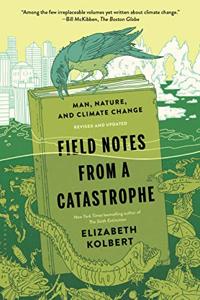
Want to learn the ideas in Field Notes From A Catastrophe better than ever? Read the world’s #1 book summary of Field Notes From A Catastrophe by Elizabeth Kolbert here.
Read a brief 1-Page Summary or watch video summaries curated by our expert team. Note: this book guide is not affiliated with or endorsed by the publisher or author, and we always encourage you to purchase and read the full book.
Video Summaries of Field Notes From A Catastrophe
We’ve scoured the Internet for the very best videos on Field Notes From A Catastrophe, from high-quality videos summaries to interviews or commentary by Elizabeth Kolbert.
1-Page Summary of Field Notes From A Catastrophe
Overall Summary
In 2006, in the wake of Hurricane Katrina, New York Times journalist Elizabeth Kolbert published Field Notes from a Catastrophe. She won an award for her political reporting for The New Yorker magazine.
Kolbert’s investigation begins in Greenland, where natives have noticed the shrinking of icebergs for years. In another northerly location, the Alaskan island of Shishmaref is disappearing underwater. Arctic sea ice has thinned by 40 percent since 1975. Climate change isn’t a new concept–in the 1850s, chemist John Tyndall won a Nobel Prize for reasoning that selective absorption must be responsible for warming; and in the 1950s, Charles David Keeling produced “the Keeling Curve,” showing increasing carbon dioxide levels over time.
In this chapter, Kolbert discusses the history of Scandinavia and how it was interrupted by multiple famines due to climate change. The Greenland ice sheet is shrinking rapidly but America’s Bush administration resisted taking action at a 2000 conference in Reykjavik. She then follows the issue south to Britain where she interviews a lepidopterist who reports that more mobile species are migrating north due to rising temperatures. Biologists in Oregon and California have studied shifting hibernation patterns and extinction of vulnerable species due to global warming which disrupts an already delicate equilibrium.
Kolbert’s investigation has two parts. The first part is about the impact of climate change on human civilization. Climate modelers have been measuring climate change since the 1980s, and they predict a temperature increase of six to seven degrees Fahrenheit by 2100. At the same time, we also know that Akkad fell due to crop failure from drought in Iraq during this time period, and that rising sea levels are causing flooding in various countries around the world. In 2003, Dutch citizens were warned about how their country might be affected by global warming within 100 years; one strategy proposed was building floating houses for people who live near water because there will be more flooding as a result of melting ice caps and glaciers (also known as “polders”). By 2100, it may become hotter than at any other point in recorded history—perhaps even 50 million years ago when there was no ice on either pole!
Robert Socolow, a physicist at Princeton University and codirector of the Carbon Mitigation Initiative, has devised 15 ways to stabilize global temperatures. However, he doesn’t account for recarbonization as countries such as China and India industrialize. America is one of the biggest emitters in the world; it emits nearly 25 percent of all greenhouse gases. In 2005, America became one of only two industrialized nations that didn’t sign on to Kyoto Protocols—a treaty designed to prevent emissions from reaching dangerous levels. Senator John McCain tried unsuccessfully to get President Bush’s signature on the bill that would have forced compliance with Kyoto regulations. Emissions continue climbing despite efforts by international leaders like Al Gore and Richard Branson who are trying to reduce them.
In response to the Kyoto Protocol, 170 U.S. mayors have signed a pledge to reduce emissions in their cities by 2012. Burlington, Vermont has been especially proactive about this issue and is ahead of any other city in the country on reducing greenhouse gas emissions. The NRDC’s climate program director David Hawkins claims that addressing China’s coal-powered growth is essential because they are following America’s example from fifty years ago when we were also increasing our use of coal for energy production. Kolbert concludes her investigation with a coinage from Nobel Prize-winning Dutch chemist Paul Crutzen who says that we have entered what he calls the “Anthropocene” where humans are now the dominant influence on climate change instead of natural forces like volcanoes or changes in Earth’s orbit around the sun as it orbits around our galaxy and others within it (the Milky Way).





